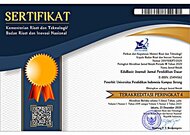Effectiveness of Audio-Visual on Male and Female Students’ Academic Performance in Social Studies
Abstract
Technology development in the modern era assists teachers in creating a collaborative learning environment. Despite the effectiveness of audio-visual materials in teaching and learning, there are still some hinderances in its usage. This study investigated the effects of audio-visual aids on students’ academic performance in social studies in junior secondary schools. This study is an experimental study and the sample comprised of 50 junior secondary schools. The audio-visual was in powerpoint format with concepts of marriage as material of the social studies. Students were given test questions after been taught with the Audio-visual and the results of the test are indicators of their academic performance. Analysis of the data was carried out using analysis of t-test analysis. The findings established that audio-visual aids had positive effect on students’ performance and there is no significant difference between the performance of male and female students taught using audio-visual aids. This study concluded that audio-visual method of teaching had positive effect on student's academic performance. Thus, this implies that the conventional method of teaching is less effective and performance oriented. It was however recommended that adequate supervision, monitoring and the use of audio-visual in teaching social studies by teachers of the schools should be encouraged and given adequate attention.
Keywords
Full Text:
PDFReferences
Abdullahi, O. E. (2015). Relationship among achievement motivation, self esteem, locus of control and academic performance of Nigerian. The Nigerian Journal of Guidance and Counselling, 7(1), 130–141.
Agbaje R. O., & Alake E. M. (2014). Students’ variable as predictor of secondary school student’s academic achievement in science subject. International Journal of Scientific and Research Publication, 4(9), 1–5.
Ajai, J. T., & Imoko, B. I. (2015). Gender differences in mathematics achievement and retention scores: A case of problem-based learning method. International Journal of Research in Education and Science, 1(1), 45–50.
Asrizal, A., Amran, A., Ananda, A., Festiyed, F., & Sumarmin, R. (2018). The development of integrated science instructional materials to improve students’ digital literacy in scientific approach. Jurnal Pendidikan IPA Indonesia, 7(4), 442–450.
El Said, G. (2017). A cloud computing-based model of e- commerce adoption for developing countries. Journal of Electronic Commerce in Organisations, 15(3), 64–82.
Ibe, E., & Abamuche, J. (2019). Effects of audiovisual technological aids on students' achievement and interest in secondary school biology in Nigeria. Heliyon, 5(6), 1–6.
İşman, A. (2012). Technology and technique: An educational perspective. Turkish Online Journal of Educational Technology (TOJET), 11(2), 207–213.
Lisenbee, P. S. (2016). Generation gap between students needs and teachers' use of technology in the classroom. Journal of Literacy and Technology, 17(3), 100–123.
Mushtaq, I., & Khan, S. N. (2012). Factors affecting students’ academic performance. Global Journal of Management and Business Research, 12(9), 17–22.
Ossai-Ugbah, N. B., Ogunrombi, S. A., & Ameh, I. O. (2012). Motivating use of audio-visuals in a Nigerian Technological University Library. Journal of Educational and Social Research, 2(1), 217–223.
Peden, R. G., Mercer, R., & Tatham A. J. (2016). The use of head-mounted display eyeglasses for teaching surgical skills: A prospective randomized study. International Journal of Surgery, 34, 169–173.
Raja, R., & Nagasubramani, P. C. (2018). Impact of modern technology in education. Journal of Applied and Advanced Research, 3(1), 33–35.
Robinson, L., Cotten, S. R., Ono, H., Quan-Haase, A., Mesch, G., Chen, W., Schulz, J., Hale, T. M., & Stern, M. J. (2015). Digital inequalities and why they matter. Information, Communication & Society, 18(5), 569–582.
Sahin, M., & Secer, S. S. Y. E. (2016). Challenges of using audio visual aids as warm up activity in teaching aviation English. Educational Research and Reviews, 11(8), 860–866.
Shamsideen, S. A. (2016). Impact of audio-visual materials in the dissemination of knowledge for facilitators in some selected literacy centres in Oshodi/Isolo local government area. African Educational Research Journal, 4(1), 19–24.
Tang, D. K. H., & Intai, R. (2017). Effectiveness of audio-visual aids in teaching lower secondary science in a rural secondary school. Asia Pacific Journal of Educators and Education, 32, 91–106.
Yemima, M., Wijayaningsih, L., & Kurniawan, M. (2019). Enhancing english vocabulary through the use of snake and ladder media for 4 to 6-year-old children. Satya Widya, 35(1), 1–15.
Yusuf, T., Onifade C. A., & Bello O. S. (2016). Impact of class size on learning behavior and general attitudes of students in secondary schools in Abeokuta, Ogun State, Nigeria. Journal of Research Initiatives, 2(1), 1–16.
DOI: https://doi.org/10.17509/ebj.v3i2.38628
Refbacks
- There are currently no refbacks.
Copyright (c) 2021 Universitas Pendidikan Indonesia
This work is licensed under a Creative Commons Attribution 4.0 International License.
This journal is indexed by




.png)




.png)
1.png)


1.png)

.png)